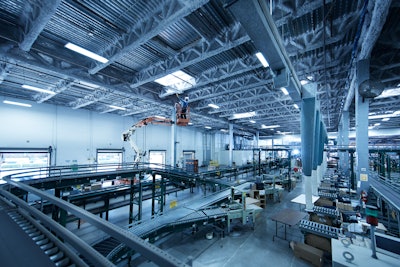
The pressure for retail distribution centers to fulfill orders quickly and accurately doesn’t appear to be letting up anytime soon. In 2020, demand for large warehouse centers hit a record high. While distribution center operators must find ways to adapt to demand, they’re also under pressure from consumers, investors and regulators to improve the sustainability of their facilities. Sustainability is also an important cost control strategy, and with more facilities operating around-the-clock distribution centers, operators need to identify every possible opportunity to reduce energy expenses and streamline their operations.
That’s where lighting comes in. Instead of being just another operating expense, lighting can play an important role in reducing energy costs and enable you to gain better control and flexibility over your operations. Here are four ways that LED lighting technology, when combined with smart lighting controls, can drive environmental benefits in distribution centers.
1. Reduce energy consumption and costs
LEDs have long been viewed as key components of a sustainable lighting strategy due to their long lifespan and high efficacy rates. LEDs are capable of producing more lumens per watt than standard fluorescent and incandescent bulbs, as well as some high-intensity discharge (HID) fixtures. Their maximum typical rated lifetime of 50,000 hours exceeds that of any other type of light source. Automated controls allow you to further maximize the energy efficiency of LEDs and reduce costs. For example, LED fixtures outfitted with photo sensors automatically adjust indoor lighting when natural light levels are high, which is known as daylight harvesting. And, occupancy sensors turn lights on and off, or dim to a lower level, depending on activity in a particular area.
2. Make smarter operational decisions with advanced lighting controls
Lighting controls can do more than automate lighting levels. Lighting fixtures can be integrated with cloud-based systems that facility managers and staff can control from handheld devices or remote computers. These systems provide data intelligence on traffic flow, occupancy levels and worker patterns. With these insights, distribution center operators can better manage lighting levels to reduce costs and energy consumption:
● Measure worker activity to identify unoccupied areas that are lit unnecessarily.
● Monitor the status of fixtures to quickly and proactively respond to maintenance issues.
● Create preset scenes and lighting zones based on work schedules to reliably ensure the proper lighting levels.
Cost concerns have traditionally been a barrier to implementing advanced lighting control systems. However, costs for sensors, fixtures and lighting control systems are coming down. And, the benefits they offer make the return on investment hard to deny. For example, fixtures can also house wireless range extenders to help boost WiFi throughout the facility. This removes connectivity barriers and allows you to implement technology and mobile devices throughout the distribution center. They also improve safety.
3. Eliminate older lighting technology containing mercury
One of the major complications of using fluorescent lamps within high bay fixtures and HIDs, both of which are common in warehouse environments, is that they contain mercury. Because mercury can’t be disposed of alongside other waste, these bulbs often end up in storage areas, where they sit until someone can devise a disposal plan for them. If one of the lamps breaks, mercury will release into the air, which is harmful to employees and the environment. LEDs, on the other hand, are not considered to be toxic and can be disposed of in the same manner as other waste.
4. Improve overall lighting quality
Improved lighting quality can have a significant impact on improving efficiencies. Better visibility allows employees to pick materials more easily and efficiently. Newer lighting technologies with a high-color rendering index (CRI) allow workers to see items as they would in natural light. In addition to reducing picking errors and the waste that comes with them, these lighting technologies can also improve worker safety and wellness. High-quality lighting helps prevent slip and falls in poorly lit areas. And, high CRI lighting allows workers to have high visibility without the eye strain and headaches that can be caused by fluorescent lighting.
You can even install circadian rhythm lighting. Different color wavelengths signal to the brain when it’s time to rest and when it’s time to be alert. With workers in the facility around the clock, implementing circadian lighting can help support healthy brain function and promote healthier sleep patterns.
These are just a few of the ways higher quality lighting makes a facility more comfortable and attractive to potential employees. And, considering how high demand is for warehouse personnel, distribution centers need all the competitive advantages they can get. Sustainable lighting allows you to address multiple facility challenges at once, but to take advantage of all of these benefits, you need the right lighting strategy. Lamp types, fixtures and lighting control system selection can all have an impact on the ability to reduce energy consumption, lower operating costs and improve worker safety. Working with a lighting expert that understands distribution center environments and can advise on the latest lighting technology will leverage these benefits cost-effectively and with minimal disruption to your operations.



















